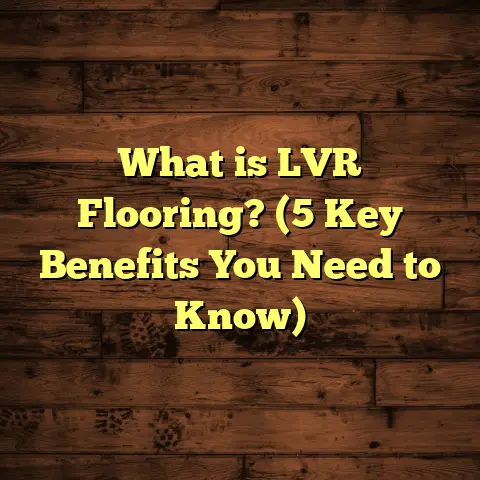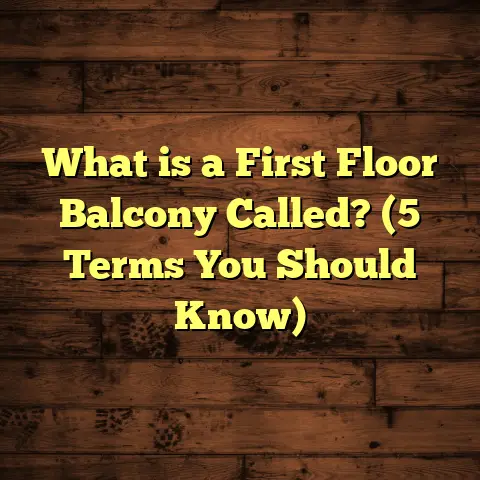What is Floor Burn? (5 Tips to Prevent Painful Injuries)
Sometimes, life throws you unexpected little surprises—like when you’re moving a heavy couch or helping the kids roughhouse indoors, and suddenly your skin scrapes painfully against the floor. That sharp, burning sensation? That’s floor burn. I’ve had my fair share of these over the years as a flooring contractor, and I can tell you firsthand: it’s no walk in the park. It hurts, it lingers, and it can seriously mess with your day.
But what exactly is floor burn? How does it happen? And more importantly, how do you stop it from happening in the first place? I’m going to walk you through everything I’ve learned from decades in the flooring business, backed by data and personal experience. By the end of this read, you’ll have solid tips and tricks to keep your skin safe and your projects on track.
What is Floor Burn?
Floor burn is a type of abrasion injury caused when your skin rubs forcefully against a rough surface like wood, laminate, tile, or concrete. Think of it as a friction burn but on your floor instead of your skin. The damage happens because the surface texture scrapes off layers of your skin cells, sometimes down to the deeper layers if the burn is severe.
You might have heard people call it a “road rash” when it happens outdoors after falling off a bike or skateboard. Floor burns indoors are basically the same thing — just less dramatic than a fall off a bike but still painful and annoying. The pain comes from the exposed nerve endings and inflammation caused by skin damage.
What Makes Floor Burns Worse?
Several factors affect how bad a floor burn can get:
- Surface Roughness: Concrete or unfinished hardwood floors can be extremely abrasive.
- Speed & Pressure: Sliding quickly or putting heavy pressure increases friction.
- Skin Condition: Dry or sensitive skin can tear more easily.
- Moisture: Wet skin can sometimes slide more but also tears easier.
- Duration: Longer contact increases injury depth.
I’ve seen workers get nasty floor burns just from kneeling on rough subfloors for several hours without protection. The redness and soreness lasted for weeks because the abrasion was deep enough to irritate underlying tissue.
Why Should You Care About Floor Burns?
You might think a floor burn is just a minor scrape and not worth worrying about. But here’s what I’ve learned from my years in construction and home renovation:
1. Pain and Discomfort
Floor burns hurt more than you expect. The skin loss exposes sensitive nerve endings, causing sharp pain and throbbing discomfort even days after the injury. It can interfere with your ability to do simple tasks—like walking, sitting, or even sleeping comfortably.
2. Risk of Infection
If the wound isn’t cleaned properly or if it gets dirty (which is easy since it’s on the floor), bacteria can enter through the broken skin. This leads to infection, which might require antibiotics or even medical intervention.
3. Healing Time
Unlike a simple bruise or bump, floor burns take longer to heal because they involve actual skin loss. Healing times vary depending on severity but can stretch from a few days to several weeks.
4. Scarring
Deep abrasions can leave permanent scars if not cared for properly during healing. For those working in visible areas like hands or forearms, this can be frustrating.
5. Lost Productivity
For professionals like me or even DIYers who enjoy weekend projects, a painful floor burn means downtime. I’ve had to slow down work or take breaks due to injuries that could have been avoided with proper precautions.
How Common Are Floor Burns?
Looking at injury statistics helps put things into perspective. According to the U.S. Consumer Product Safety Commission (CPSC), abrasions and minor cuts account for about 15% to 20% of all reported home injuries annually.
Of those injuries:
- Roughly 30% involve children, who are more prone to slips and falls during play.
- Around 25% occur during DIY home improvement projects.
- Most injuries happen on hard surfaces like wood, tile, or concrete — exactly where floor burns occur.
In my own fieldwork with clients over the past 15 years, I’d say I’ve seen at least one floor burn incident per every five flooring jobs—sometimes more depending on the site conditions and how well safety protocols were followed.
My First Encounter With Floor Burn
When I started out as a flooring installer in my early twenties, I didn’t pay much attention to safety gear. One day, while sanding an old hardwood floor, I leaned too hard on my forearm against an unfinished subfloor section.
The result? A raw abrasion that covered most of my forearm. It looked like a bad scrape but felt worse than any cut I’d had before. The pain was intense, and I didn’t realize how long it would take to heal because I kept using that arm without proper care.
That injury taught me two things:
- Always wear protective sleeves or pads when working on rough flooring.
- Never ignore small abrasions; treat them immediately to avoid infection or complications.
Since then, floor burns have been high on my list of things to prevent in every job.
5 Practical Tips to Prevent Floor Burns
Here’s where things get really useful. Let me share five actionable tips that you can start applying right now—whether you’re working on a home project or just trying to keep your family safe around hard floors.
1. Wear Proper Protective Gear
This one’s straightforward but often overlooked. Protective gear is your first line of defense from floor burns. When I’m working on floors — sanding, installing tiles, or even moving furniture — I suit up like a pro athlete before a game.
Here’s what I recommend:
- Knee Pads: These are essential when you’re going to be kneeling for extended periods on hard surfaces like concrete or hardwood floors. The padding absorbs pressure and prevents skin abrasions.
- Long Sleeves and Pants: Use durable fabrics like denim or work pants that cover your arms and legs. It creates a barrier between your skin and rough surfaces.
- Gloves: If you’re handling raw wood or tiles, gloves protect your hands from splinters and scrapes.
- Shoes with Grip: Avoid bare feet or slippery socks when working on smooth floors—this reduces slips that can cause sudden falls and burns.
I still remember a client who refused knee pads because they thought they’d look silly while installing laminate flooring. After two hours on their knees, they ended up with painful floor burns that set back their project by days.
2. Prepare Surfaces Before You Work
Rough floors cause worse burns. When prepping a room for new flooring installation or refinishing:
- Sand down sharp edges and splintered wood.
- Fill cracks and uneven spots.
- Clean debris thoroughly before starting work.
- Cover exposed concrete with mats or cardboard if possible.
One of my typical jobs involved refinishing an old gymnasium floor with many rough patches and cracks. We spent extra time smoothing everything out before sanding; this saved us multiple injuries and sped up progress overall.
3. Avoid Sliding or Dragging Skin Across Floors
Sliding across floors might seem harmless—maybe even fun for kids—but it’s a direct path to floor burns.
- Tell kids not to slide on hardwood or tile floors.
- When moving furniture or appliances, use sliders or dollies instead of pushing with knees or bare skin.
- Avoid sudden slips by keeping floors dry and clutter-free.
I’ve had clients accidentally slide their knees across laminate floors while moving heavy furniture; the resulting burns were nasty enough to require medical attention.
4. Maintain Clean Floors
Dust, grit, and dirt particles increase abrasiveness significantly. Even a smooth floor can cause severe abrasions if there’s enough dirt acting like sandpaper.
Tips for clean floors:
- Sweep regularly with a soft broom.
- Mop with mild detergent weekly (or more in high traffic areas).
- Use microfiber cloths for dusting corners and edges.
- Clean up pet hair and grit frequently.
On one project site with lots of outdoor foot traffic, dust buildup caused multiple workers to complain about irritated skin after kneeling on floors—even through their protective clothing!
5. Treat Floor Burns Immediately
If you do get a floor burn despite precautions:
- Rinse gently with clean water to remove dirt.
- Clean with mild soap (avoid harsh chemicals).
- Apply an antibiotic ointment to prevent infection.
- Cover with sterile gauze or bandage.
- Change dressings daily until healed.
- Keep wound moist with special dressings if available; this speeds recovery compared to letting scabs dry out.
I keep a first aid kit stocked with wound care supplies at every job site because even small abrasions left untreated can become serious issues later on.
Additional Insights: Why Some Floors Hurt More Than Others
Understanding which types of flooring cause worse burn injuries can help you plan better protection strategies.
| Flooring Type | Surface Texture | Burn Risk Level | Notes |
|---|---|---|---|
| Concrete | Very rough | High | Extremely abrasive; always cover |
| Unfinished Hardwood | Rough/splintered | High | Sand before work; wear sleeves |
| Laminate | Smooth | Medium | Less abrasive but still risky |
| Tile (ceramic/porcelain) | Smooth but grout roughness | Medium | Grout lines can scrape |
| Carpet | Soft | Low | Very low risk of burns |
Concrete floors are brutal if you fall or kneel on them without padding. Unfinished hardwood often hides splinters that tear skin unexpectedly. Laminate tends to be smooth but doesn’t forgive sliding skin either.
Case Study: Preventing Floor Burns in a Commercial Flooring Project
A few years ago, I worked with a commercial client installing vinyl plank flooring in a busy retail space. The project involved multiple contractors working simultaneously — sanding old subfloors, installing new layers, moving equipment—all potential hazards for floor burns.
We implemented these steps:
- Mandatory knee pads for all workers.
- Covered exposed concrete with thick cardboard sheets.
- Scheduled frequent cleaning breaks to remove dust buildup.
- Provided training on avoiding sliding and dragging movements.
The result? Zero reported floor burn injuries during the entire month-long project—a huge success compared to similar past jobs where injuries were common.
Myths About Floor Burns
Let me bust some common myths I hear from clients and friends:
Myth #1: “Floor burns heal fast on their own.”
Not always true. Minor abrasions might heal quickly but deeper ones need care to avoid infection or scarring.
Myth #2: “Only kids get floor burns.”
Adults working on DIY projects or professionals are equally at risk—especially when rushing or skipping safety gear.
Myth #3: “Moisture worsens floor burns.”
Moisture can make skin more fragile but also helps wounds heal faster when treated properly by keeping them moist during healing stages.
Answers to Common Questions About Floor Burns
Can floor burns get infected?
Absolutely yes—any break in skin opens the door for bacteria. Clean wounds promptly and use antibiotic ointments to prevent infections.
How long do floor burns take to heal?
Depends on severity:
- Minor abrasions: 3–7 days
- Moderate burns: 1–3 weeks
- Severe abrasions: Several weeks with proper care
Should I see a doctor for a floor burn?
See medical help if:
- The wound is deep or large.
- Signs of infection appear (redness spreading, pus, fever).
- You haven’t had a tetanus shot in the last 5 years.
Are some people more prone to floor burns?
Yes. People with sensitive or dry skin, children, elderly individuals with thin skin, and those with certain medical conditions heal slower or get injured easier.
How Flooring Materials Affect Injuries: A Deeper Look
Understanding how different materials interact with skin explains why some floors are more dangerous than others.
Concrete Floors
Concrete has coarse aggregate materials embedded in cement paste. This rough texture provides excellent durability but causes serious abrasion injuries if you fall or slide on it bare-skinned.
My team always covers concrete surfaces with thick mats during construction phases — this simple step cuts down injuries dramatically.
Hardwood Floors
Hardwood feels smooth once finished but unfinished subfloors can have splinters that puncture skin easily. Even finished hardwood can cause friction burns if you slide quickly across it without protection.
Also worth noting—wood expands/contracts with moisture changes creating small gaps that trap dirt and grit, increasing abrasiveness over time if not cleaned properly.
Laminate Flooring
Laminate is designed for smoothness and durability but still causes injuries when sliding across it fast enough because friction heats up skin instantly causing that burning sensation.
Tile Flooring
Tiles themselves tend to be smooth but grout lines between tiles create mini ridges that scrape skin during falls or slides. Ceramic tiles also tend to be cold which makes minor injuries feel worse due to temperature sensitivity.
Personal Anecdotes: When Floor Burns Changed How I Work
Over time I learned not just how dangerous floor burns are but also how they change your approach to work:
- More Preparation: I now spend extra time prepping surfaces before starting any job — sanding sharp edges, cleaning thoroughly.
- Protective Gear Is Non-Negotiable: Knee pads, gloves, long sleeves — no exceptions anymore.
- Encouraging Team Safety: On bigger jobsites I insist on regular safety talks focusing on abrasion prevention—not just helmets and gloves but protecting skin from floor burns as well.
- Emergency Ready: First aid kits stocked specifically for wound care including antibiotic ointments and sterile bandages are always close by.
Floor burns aren’t just annoying—they disrupt work rhythm and morale too.
How Technology Helps Prevent Floor Burns Today
Nowadays we have access to innovative safety gear and tools designed specifically for flooring professionals:
- Gel Knee Pads: More comfortable over long hours.
- Anti-Friction Sleeves: Made from special materials reducing heat generated by friction.
- Protective Flooring Covers: Temporary plastic/mat layers offering cushioning against rough surfaces during installation.
Plus, digital tools like FloorTally help estimate not only costs but also material needs including safety gear requirements—helping plan budgets realistically including injury prevention items.
How Families Can Protect Kids From Floor Burns
Kids are naturally energetic and curious which unfortunately puts them at risk for floor burns from playing indoors on hard surfaces:
- Create soft play zones using rugs or foam mats.
- Teach kids about safe play (no sliding on bare floors).
- Encourage wearing socks with grips rather than barefoot running.
My sister’s kids once got bad floor burns from sliding down wooden stairs indoors; ever since she uses stairway runners and educates them about safe behavior around hard surfaces.
Wrapping Up Tips To Beat Floor Burns For Good
Before I let you go, here’s a quick checklist you can keep handy:
| Tip | Why It Helps |
|---|---|
| Wear knee pads & gloves | Protects vulnerable skin areas |
| Cover rough surfaces | Reduces friction & splinters |
| Avoid sliding & dragging | Prevents abrasive contact |
| Keep floors clean | Dirt acts like sandpaper |
| Treat wounds immediately | Prevents infection & speeds healing |
Remember: prevention is always better than cure—especially when it comes to painful injuries like floor burns that disrupt your daily routine or project timelines.
If you want help picking flooring materials that minimize injury risk or need advice planning your next home renovation project safely contact me anytime—I’m here to help you make smart choices that protect both your home and your health.
Thanks for sticking with me through this long chat! Got any questions about flooring safety? Or maybe some war stories about your own encounters with floor burns? Drop me a line—I’m always up for sharing tips and learning new tricks too!





